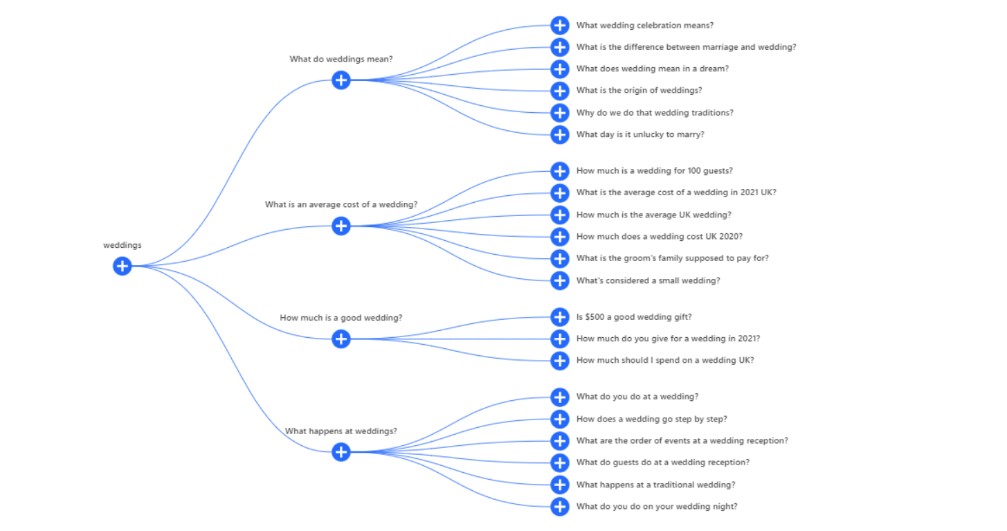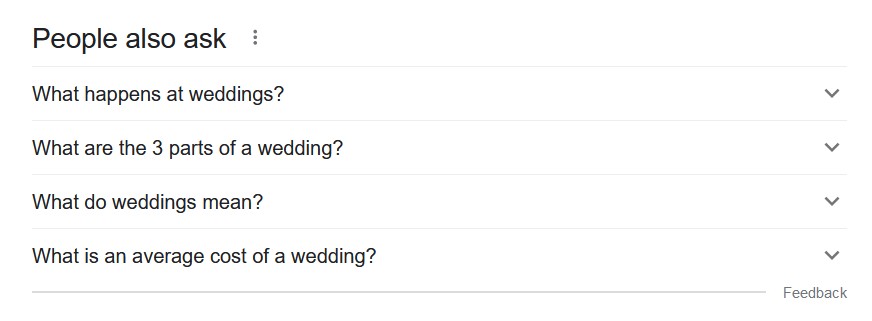Even in the age of Artificial Intelligence, where AI summaries in search are reducing website click-throughs, there’s still a lot of business value in creating high-quality blog posts. They’re helpful to your customers, demonstrate your expertise in a subject, and help keep your website content fresh.
Aside from sharing helpful and relevant information, blog posts should be properly optimised for search and AI in order to improve your website’s overall performance. So here are five tips to help you improve your existing and older blog content for search success.
Jump to
1. Use Also Asked and Answer the Public for Keyword Research
Keyword research is important to create structure and relevance for your content. You can find out what people are searching, and the questions they want answered. It can also provide inspiration by highlighting related topics that you can either cover in your current blog post or use for future content.
Also Asked and Answer the Public are two online freemium tools that are extremely handy when researching a topic.

Also Asked
Also Asked uses Google’s “People Also Asked” feature to present a set of questions related to your chosen keyword or subject. The information is taken from real searches so you can see what people are actually asking around your topic. The results are helpfully grouped so that you can delve deeper into a topic and see how queries are related.
For example, by searching the word ‘wedding’ in Also Asked, one of the top results is what do I need to organise when I get married. If you’re in the wedding industry, then this could be perfect inspiration for a blog.
Also Asked will then let you select this specific question (or others) to find more keywords and questions that are specifically relevant to this topic.
The site allows 3 free searches per day without an account. There are tiered paid options if you want more daily searches.
Answer the Public
Answer the Public is slightly different but works nicely in tandem with Also Asked. This site uses the auto complete data you see when typing a phrase into Google. Just like Also Asked, you are given lots of questions related to your keyword. These are grouped in various ways, including alphabetically, by question, or by preposition. A handy colour palette also helps you see the popularity of each search term.
With a free account, you get three daily searches. Paid subscriptions are available from a very reasonable monthly fee (£11 at the time of writing).
2. Include an FAQ

During your keyword research, you’ll come across lots of blog content inspiration. You’ll also likely find a lot of specific questions that your target audience is asking. While you might answer these questions within the main content of your blog, it’s also a good idea to have a shorter, skimmable FAQ section within your post. Ideally, this should include Schema Markup, but even without implementing this technical SEO, an FAQ is a great way to help your audience and get noticed by Google.
The FAQ section should include the most commonly asked questions. These should be answered as fully and as clearly as possible in a short space. By doing so, you help users find quick answers to specific questions, and you also improve your chances of your content being picked up by AI and chatbots, helping to boost your visibility in search and drive more website traffic. The main content can go into deeper detail on each question if needed.
3. Look at Similar Top-Ranking Articles
Before you start writing, search your blog subject in Google and see what ranks in the top results, or in the AI summaries. This gives you a fantastic idea of the type of content that does well on Google (and on other search engines). By emulating the content in the top results, you’re giving your site a boost because you’re mimicking tried and tested content without spending months and years researching what works best.
That’s not to say that you should completely copy the top content – you’re just using it for inspiration and guidance. Bringing something new is always beneficial, and Google is very good at identifying plagiarised content. Examining the top results is just like studying the work of someone more experienced than you so that you can learn and improve.

Studying the top results also gives you an idea of what the searcher actually wants to know, i.e. their intention. Intention is important because it will help you focus your content and decide whether this subject is right for you.
For example, someone searching sailing in the Lake District might be looking for somewhere to launch their own boat, or somewhere to hire a boat. By entering this phrase into Google, however, the top results are all about boat hire. This tells you to either focus your content on boat hire for this particular target phrase, or else change your keyword to match the intention you want to target.
Finally, reviewing the top results will also help you identify what isn’t being said. Does your keyword research flag a question that’s often searched but rarely answered. This type of data is gold dust in the SEO world and gives you an opportunity to get ahead of your competitors by answering the questions they’ve missed.
4. Update and Refresh Old Blogs
Too often we spend hours carefully crafting a blog, fully optimising it, and then never looking at it again. The truth is that, by doing this, you’re missing out on some fantastic SEO opportunities.
Take a look at Google Analytics and find out which of your blogs receive the most traffic, or look on Google Search Console to find which ones rank on page two or at the bottom of page one on Google. Then go through those blogs, refresh them, correct any outdated information, update and add relevant resources, and change the publication date. You could also consider adding the current year to the title so readers know they’re getting the most up-to-date information.
This kind of evergreen content is fantastic for SEO, and by keeping it up-to-date you’re telling search engines that the information is still relevant and useful.
But what about blogs with date-specific URLs? To use my wedding example from earlier, you could have a blog called Top 10 Wedding Trends of 2015, with the slug /top-10-wedding-trends-2015, that you want to update for the current year. Follow these steps to make sure you don’t lose the SEO benefits from the old blog:
- Create a new blog without the date in the URL (e.g. /top-10-wedding-trends).
- Copy over the title and content from the old blog and make any updates. You can still keep the current year in the title if you want.
- Delete the old blog and 301 redirect the old URL to the new one.
- Update any internal links so that they point to the new URL instead of the old one.
5. Combine Previous Blogs to Create a Long-Form Guide
Long-form content can be a real winner when it comes to SEO, as long as it’s carefully laid out with skimmable sections using descriptive headings and short paragraphs.
One way to create long-form content is by combining several of your existing shorter blogs on a similar subject. By pulling together separate but related information, you’ll create an in-depth and informative guide that’s thorough and useful to your target audience.
Looking at the wedding example again, you may have several short blogs that cover how to pick out a wedding dress, how to choose a caterer, when to send out invitations, and so on. Combined, you’ve got a proposal-to-wedding-day guide called Everything You Need to Plan Your Perfect Wedding – a go-to guide for any bride- or groom-to-be!

When combining multiple blogs into a comprehensive guide, remember the following:
- Read through all the content to sense-check it and ensure everything is still up-to-date.
- Add 301 redirects from the now-defunct shorter blog posts to the fuller guide.
- Update any internal links that were pointing to the blogs so that they now go to the new guide.
- Make use of proper headings to delineate sections and sub-topics within the page.
- Add a table of contents and anchor links to allow users to easily navigate the page and find the particular information they want.
Longer guides are not only helpfully comprehensive, but they provide answers to lots of different search questions, sending more traffic to that one page (instead of splitting traffic across several pages), and giving you more SEO brownie points.
An alternative to this – which works especially well if your “shorter” guides are actually still quite long – is to create a pillar page. This is a single page that summarises a broader topic, and links to all the related individual blogs. It doesn’t have all the content on one page, but links related pages together for better understanding and navigation.
Conclusion
Blog content still has a big part to play in search engine optimisation, even in the age of AI, but improving and creating blogs doesn’t always have to involve hours and hours of work. Make use of the tools out there, learn from others, take advantage of your top-ranking content, and continue to inform and help your visitors for success in search.
